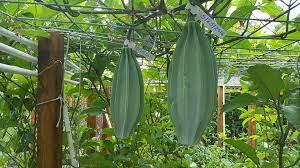
Agriculture plays a vital role in Nigeria's economy, and one profitable venture within the agricultural sector is Ugu farming. Ugu, also known as Pumpkin Leaf, is a highly nutritious and versatile vegetable widely consumed in Nigeria. Its popularity has created a lucrative market for Ugu farmers.
Health benefits of Ugu leaf
Ugu leaves (fluted pumpkin) leaves is one of those plants that secretly carry some unbelievable health benefits such as; Ugu leave can be used as an ingredient for herbal medicines. It helps to treat malaria, anaemia and sudden attack of convulsion. It has other health benefits too, like -Liver-protection; Lactating properties, excellent for nursing mothers; Boosts the immune system; It increases fertility.
Ugu leaves can be consumed raw or used for cooking. The seed is edible, as it can be used as snacks by roasting or boiling it.
If you are considering starting a Ugu farming business in Nigeria, this comprehensive guide will provide you with the necessary information to get started successfully.
Conducting Market Research
Before venturing into Ugu farming, it is essential to conduct thorough market research. This will help you understand the demand, pricing, and competition in the market. Identify potential buyers such as local markets, supermarkets, hotels, restaurants, and export opportunities.
Choosing the Right Location
The choice of location plays a crucial role in the success of your Ugu farming business. Ugu thrives in well-drained, fertile loamy soil with a pH level between 6.0 and 7.0. Consider areas with adequate sunlight and access to water sources for irrigation. It is also advisable to select a location close to your target market to minimize transportation costs.
How to prepare Ugu seed for planting
Cut the ugu pod, bring out the seeds and dry them under sun for only a day or two, do not allow them to be over dried in other to preserve the viability of the seed. The drying of the seeds helps them to be resistant to pest which could have eaten them off in the soil, it also prevent them from decaying.
Don’t dry the seeds that have already sprouted, the sun will kill them.
Soil Preparation and Planting
Prepare the soil by clearing weeds, rocks, and debris. Ugu requires organic-rich soil, so incorporate organic matter such as compost or manure into the soil before planting. It is recommended to perform a soil test to determine its nutrient content and make necessary amendments.
Ugu can be propagated using seeds or stem cuttings. If using seeds, soak them in water overnight before planting. Create mounds or ridges to enhance water drainage and sow the seeds or plant the cuttings at a spacing of about 60 cm between rows and 30 cm between plants. Provide adequate irrigation to ensure the plants receive sufficient moisture.
Crop Management
Maintaining a healthy Ugu crop requires diligent management practices. Here are some essential steps:
a. Irrigation: Ugu requires regular watering, especially during dry spells. Ensure the plants receive about 25-30 mm of water per week. Drip irrigation is highly recommended for efficient water use.
b. Fertilization: Apply organic or inorganic fertilizers to supplement the soil's nutrient content. Conduct soil tests periodically to determine the specific nutrient requirements of your Ugu crop. Fertilize accordingly to promote healthy growth and maximize yields.
c. Weed and Pest Control: Regularly weed your Ugu farm to prevent competition for nutrients and space. Apply appropriate herbicides or use manual methods to control weeds. Implement integrated pest management techniques to address common Ugu pests such as aphids, leaf miners, and caterpillars.
Harvesting and Post-Harvest Handling
Ugu leaves are ready for harvest within 6-8 weeks after planting, depending on the variety and growing conditions. Harvest when the leaves are young, tender, and dark green. Use a sharp knife or scissors to cut the leaves carefully, leaving the stem intact for regrowth.
After harvesting, sort and clean the leaves to remove any debris or damaged portions. Proper post-harvest handling is crucial to maintain the quality and increase the shelf life of Ugu. Store the leaves in a cool, dry place or refrigerate them to prevent wilting and decay. Consider using appropriate packaging materials to protect the leaves during transportation.
Economics of pumpkin cultivation
Pumpkin is one of the most consumed vegetables in Nigeria. An acre size of the vegetable farm is capable of turning in about N 500,000 in a cycle of four months and it will take you less than N 100,000 to cultivate.However, strategic marketing to hotels, eateries and hostels could make the farming more profitable than selling through the middle women.
Marketing and Sales
Develop a marketing strategy to reach potential buyers and establish partnerships. Advertise your Ugu produce through various channels such as local markets, online platforms, and social media. Networking with restaurants, hotels, and supermarkets can provide a steady market for your Ugu leaves. Additionally, explore export opportunities by complying with international quality standards and packaging requirements.
Conclusion
Ugu farming in Nigeria presents a profitable business opportunity due to the high demand for this nutritious vegetable. By conducting market research, selecting the right location, implementing proper crop management practices, and developing an effective marketing strategy, you can establish a successful Ugu farming business.
Remember to continually improve your knowledge through training and staying updated with the latest farming techniques to enhance productivity and profitability. With dedication and commitment, you can thrive in the Ugu farming industry in Nigeria.






















